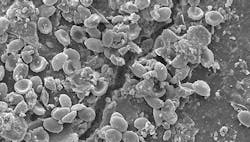Fungi-Infested Plastics Pose Health Threat
A new threat to human, animal and plant health from microplastics has emerged, with the finding that they have become a habitat for pathogenic fungal species.
The work, carried out by researchers at the German universities of Bayreuth, Hannover and Munich, shows that microplastics both host and accumulate fungal pathogens in terrestrial ecosystems.
The researchers say this is the first time such accumulations have been observed and, in a recent issue of Scientific Reports, urge policy makers to classify plastic debris as a potential threat to human health.
Using high-throughput methods, the researchers analyzed fungal communities in soil samples taken from a marketplace, a dump site, a roadside, and a courtyard near human settlements in western Kenya.
“We were able to observe all stages of fungal biofilm formation on the microplastic particles recovered from the soil samples. In doing so, we were able to demonstrate that fungi not only grow, but also reproduce in the so-called plastisphere. The data we obtained from microscopic examinations and DNA analyses supports the assumption that fungi systematically colonize microplastics in the soil,” explains Gerasimos Gkoutselis, of Bayreuth’s Department of Mycology and lead author of the study.
“Moreover, they provide evidence that microplastic in soil accumulates certain pathogenic fungal species. Some species dangerous to humans, including black fungi and cryptococcal yeast fungi, are present on the surfaces of microplastic particles in higher concentrations than in the surrounding soil. Our study therefore justifies the presumption that microplastics in soil are a potential source of fungal infections,” he adds.
[pullquote]
Importantly, say the researchers, they also found potentially human pathogenic fungi that have been previously linked to plastic colonization in other contexts, including: Fusarium oxysporum and Alternaria alternata which form biofilms on indoor and landfill plastics; members of Cladosporium, Phoma and Curvularia which have been isolated from environmental plastic particles; and the Rhodotorula species which are known to colonize plastic catheters in hospitals.
The researchers also detected a significant association with microplastic by several opportunistic pathogens, such as N. difuens, a cryptococcal yeast known to be able to cause subcutaneous pathologies in humans, and P. herbarum, a filamentous species causing a spectrum of infections in humans — especially in those with suppressed immune systems.
Infections of humans by plastic-associated fungi already have been observed in Kenya and other parts of Africa, with Fusarium oxysporum causing keratitis epidemics and Rh. mucilaginosa causing fungemia in hospital patients. Both fungi were found in this study among the dominant or enriched species on plastic waste.
The study notes that the impact of pathogen-infested plastic waste may be particularly critical in tropical regions, which receive massive influxes of plastic waste due to underdeveloped waste management.
“Aggravatingly,” they write, “fungal pathogens are most abundant in tropical and subtropical soils. Thus, microplastics in countries such as Kenya could contribute to the already extremely high fungal infection-related mortality and morbidity of the population. Due to the longevity of most plastic types and the fact that fungi can thrive and most likely proliferate within the plastisphere, the pathogen load on its surface is likely to increase over time and may result in an enhanced pathogen-carrying capacity of ecosystems.”
In this scenario, say the authors, shifts in the structure and functionality of soil mycobiomes are likely to occur, eventually culminating in biodiversity losses and extinction of local species. Wind can transport plastic particles in the topsoil over long distances across ecosystem boundaries, which may result in habitat expansion of attached fungi. In this way, pathogens will become invasive in other habitats or directly transmitted to unprotected hosts.
If colonized plastic fragments enter a long-range, fluctuating cycle of transport and fallout during the plastic cycle, spill-over events and epidemics could increase in frequency, with microplastics serving the function of artificial “super-spreaders,” they caution.
The researchers also note that Kenya has had a progressive strategy to deal with plastic waste, especially single-use plastics, for many years. The country has joined an alliance to impede import of plastic waste from industrialized countries.
“The fact that we discovered numerous potentially pathogenic fungal colonies in the soil samples from Kenya is a clear indication of the urgency of the problem in tropical regions in general, where the rate of fungal infections is already high,” emphasizes Gerhard Rambold, professor and head of Bayreuth’s Department of Mycology.
“Our study shows that measures to prevent plastic waste from entering the environment and to further develop waste management are urgently needed globally,” he concludes.
Seán Ottewell is Chemical Processing's editor at large. You can email him at [email protected].

